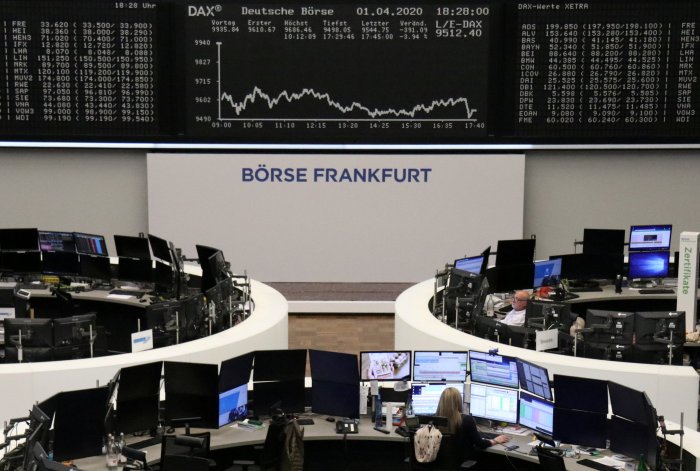WASHINGTON (Reuters) – The number of Americans filing claims for unemployment benefits shot to a record high of more than 6 million last week as more jurisdictions enforced stay-at-home measures to curb the coronavirus pandemic, which economists say has pushed the economy into recession.
Thursday’s weekly jobless claims report from the Labor Department, the most timely data on the economy’s health, reinforced economists’ views that the longest employment boom in U.S. history probably ended in March. With a majority of Americans now under some form of lockdown, claims are expected to rise further.
Economists said worsening job losses underscored the need for additional fiscal and monetary stimulus. President Donald Trump last week signed a historic $2.3 trillion package, with provisions for companies and unemployed workers. The Federal Reserve has also undertaken extraordinary measures to help companies weather the highly contagious virus, which has brought the country to a halt.
“These data underscore the magnitude of the stop-work order that has been imposed on the economy,” said Conrad DeQuadros, senior economic advisor at Brean Capital in New York. “The scale of the increase should also focus policymakers on getting the cash into the economy with possibly a fourth fiscal package and additional Fed lending programs.”
Initial claims for state unemployment benefits surged 3.341 million to a seasonally adjusted 6.648 million for the week ended March 28, the government said. That was double the previous all-time high of 3.307 million set in the prior week.
Economists polled by Reuters had forecast claims would jump to 3.50 million in the latest week, though estimates were as high as 5.25 million. The number of people on unemployment rolls shot up 1.245 million to 3.029 million in the week ended March 21, the highest since July 6, 2013.
The United States has the highest number of confirmed cases of COVID-19, the respiratory illness caused by the virus, with more than 214,000 people infected. Nearly 5,000 people in the country have died from the illness, according to a Reuters tally.
The Labor Department said states continued to identify layoffs related to COVID-19 across a broad array of industries, including accommodation and food services, health care and social assistance, manufacturing industries, retail, wholesale trade and construction industries.
“Similar to last week’s unemployment claims numbers, today’s report reflects the sacrifices American workers are making for their families, neighbors, and country in order to slow the spread,” U.S. Labor Secretary Eugene Scalia said in a statement.
The dollar <.DXY> was trading higher against a basket of currencies, while U.S Treasury prices rose. Stocks on Wall Street gained as a recovery in oil prices outweighed the shock of the jobless claims data.
(GRAPHIC: Unemployment benefits claims hit all-time high – https://fingfx.thomsonreuters.com/gfx/mkt/jbyprrzrpeo/Pasted%20image%201585835392808.png)
VIRUS DEPRESSES IMPORTS
The coronavirus pandemic’s disruptive impact was highlighted by a separate report from the U.S. Commerce Department on Thursday showing a collapse in Chinese imports, resulting in the U.S. trade deficit narrowing 12.2% to $39.9 billion in February, the lowest level since September 2016.
While the shrinking trade gap is a positive in the calculation of gross domestic product, declining imports mean less inventory accumulation, which could offset the contribution to GDP. The shortages stemming from meager imports are weighing on consumer spending and production at factories, which could lead to further job losses.
Economists believe the economy slipped into recession in March. The National Bureau of Economic Research, the private research institute regarded as the arbiter of U.S. recessions, does not define a recession as two consecutive quarters of decline in real gross domestic product, as is the rule of thumb in many countries. Instead, it looks for a drop in activity, spread across the economy and lasting more than a few months.
“The U.S. economy is now in recession,” said Gus Faucher, chief economist at PNC Financial in Pittsburgh. “Enormous job losses could do tremendous long-lasting damage to the economy that would weaken any eventual recovery.”
Applications for unemployment benefits peaked at 665,000 during the 2007-2009 recession, when 8.7 million jobs were lost. Unadjusted claims in California soared 692,394 last week. New York, another COVID-19 hot spot, reported an increase of 286,404.
Economists say the country should brace for jobless claims to continue escalating, partly citing generous provisions of the fiscal package and the federal government’s easing of requirements for workers to seek benefits.
As a result, self-employed and gig workers who previously were unable to claim unemployment benefits are now eligible. In addition, the unemployed will get an additional $600 per week for up to four months. This is on top of existing jobless benefits, which averaged $385 per person per month in January, and is equivalent to $15 per hour for a 40-hour workweek.
By comparison, the government-mandated minimum wage is about $7.25 per hour. Last week’s claims data has no bearing on the closely watched employment report for March, which is scheduled for release on Friday. The government surveyed businesses and households in the middle of the month for the employment report, when just a handful of states were enforcing “stay-at-home” or “shelter-in-place” orders.
It is, however, a preview of the carnage that awaits. Retailers, including Macy’s <M.N>, Kohl’s Corp <KSS.N> and Gap Inc <GPS.N>, said on Monday they would furlough tens of thousands of employees, as they prepare to keep stores shut for longer.
According to a Reuters survey of economists, the government report on Friday is likely to show nonfarm payrolls dropped by 100,000 jobs last month after a robust increase of 273,000 in February. The unemployment rate is forecast to rise three-tenths of a percentage point to 3.8% in March.
“The broader stimulus package contains many weaknesses that reduce its effectiveness, which is regrettable because the job loss we have seen so far is just the tip of the iceberg,” said Heidi Shierholz, a former chief economist at the Labor Department.
“Based on new GDP forecasts, we project that nearly 20 million workers will be laid off or furloughed by July, with losses in every state,” added Shierholz, now a policy director at the Economic Policy Institute in Washington.
(Reporting by Lucia Mutikani; Editing by Dan Burns, Chizu Nomiyama and Paul Simao)





















